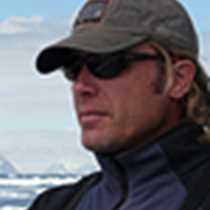Pond Island, Saginaw Bay
The call came early, well before breakfast. However, we had all embarked upon an Alaska expedition, not a ‘cruise.’ Flexibility is not just a word in this game; it is one of the fundamental tenets which govern Lindblad’s operations in any clime. “Ladies and gentlemen we have some humpback whales around our vessel. So grab your cameras and binoculars and join us on deck.”
For safe and respectful viewing of the leviathans, the National Geographic Sea Lion had slowed her speed considerably. This may have given some of us pause, as we had embarked the vessel in Sitka in rain and gathering winds. We had pounded through some swells during the night. Perhaps conditions had improved. Many leapt to the decks in anticipation of improved weather, only to quickly retreat to the cabins for more layers. The winds were middling but steady. Layers of gray surrounded and pressed down upon us. A light rain was falling. Only a reduction in speed and a near-shore lee ameliorated the inclement conditions to our travel over water, but the weather itself was unchanged from the previous evening.
For the next thirty minutes, swaddled in wool, fleece, and Gore-Tex, we watched as perhaps eight to ten humpbacks made leisurely, shallow feeding dives. Two humpbacks appeared to be a cow/calf pair. A few of them were large, full-grown adults. The rocky shoreline was steeply graded, allowing some of them to feed perhaps just a few meters from land in waters that were deceptively deep to the casual observer. The whales were all around our vessel – in close and on the horizon. The sea here was rich with food. They exploited this vital seasonal resource in a series of shallow dives, lazily raising their flukes to swim below the waves. Few were down for more than three minutes before rising to the surface to breathe. Our proximity was so tight that even their respirations were clearly audible. Their diagnostically large white pectoral flippers, the barnacles rimming their flukes, and even the hair follicles on their blubbery hides were details only attainable by the slow and sensitive approach of the bridge crew.
During breakfast, our vessel dropped the hook off Pond Island on the east side of Baranof Island. This small islet is a favorite haunt of Lindblad operations in Southeast. In a short stretch, it offers a veritable cocktail of northwest temperate rainforest ingredients. Mature coniferous forest, meadows, shallow lakes evolving to muskeg, and intertidal shores are here. This was our initiation to what a temperate rainforest is all about, in virtually all stages of succession. A series of walks from the Sitka alder-lined beach’s edge, through stands of Sitka spruce and western hemlock, across beaver dams, and over developing bog-like communities, led us through an array of habitats that trace Southeast Alaska’s evolution from Wisconsin ice-age barrenness terrain to slowly maturing blanket bogs. We saw it all here, from the micro flora on a mat of muskeg to the tallest of temperate conifer trees.
The afternoon weather gave us more of SE Alaska’s lifeblood – rain and gathering winds. The character of Southeast seemed to shift further to the dark side. The Gulf of Alaska is the very breeding ground of storms. Cold air blowing off the Siberian land mass strikes the moisture-laden air of the warm Japanese current. The cauldron boils and bubbles, and a succession of lows, like jets of steam from a kettle, shoot eastward along the Aleutian chain, gather more momentum in the Gulf, then drop down along the outer coast to spend their fury in Southeast Alaska. Entering the great waterway of Chatham Strait, after leaving the relative protection of Pond Island, we took this energy head-on to our bow. Our ship heaved and lurched through the mounting swells. The air was icy and bitter. Rain began to fall in a steady stream. For the next few hours, our vessel beat a southerly course through wind-whipped white caps churned by the gray gloom.
By mid-afternoon the sea state calmed and the winds began to abate. The rugged mountains of Kuiu Island to the south of Frederick Sound had offered us a reprieve from the inclement onslaught. In short time the winds had died, the seas calmed to liquid gray. We anchored in Saginaw Bay to explore the ancient limestone shoreline. The cobbled beach of Saginaw’s eastern side rises steeply to ancient cliffs. These sharp and angled walls tell a unique tale. This section of SE Alaska was once a coral reef, under warm Permian seas. Carried upon the Earth’s great crustal plates over the course of eons, this section of coast now rests in very different climes. With close inspection, the layers of rock can be deciphered. Brachiopods (lampshells), bryozoans, fusilinids, and crinoids (sea lilies), among others are interred here in fossilized form. These ancient invertebrates are the recipients of a long, slow, and perhaps, tortured, geologic journey to cooler northern reaches. Scanning the rocky faces, we were reading a bit more of the complex book that is the tale of present-day Southeast Alaska.




